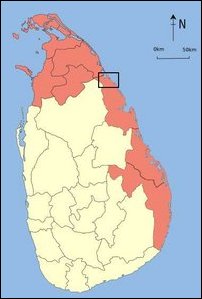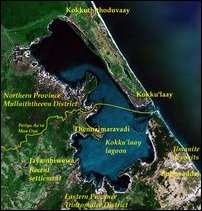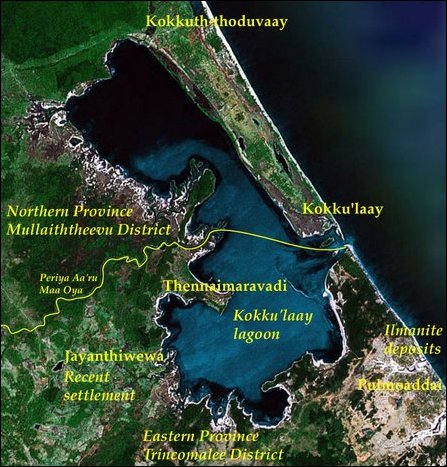
Hasty Sinhala colonisation wedges north and east at Kokkulaay
[TamilNet, Monday, 31 January 2011, 12:40 GMT]
Within the last three weeks, 240 Sinhala families were hastily settled at Kokkulaay, a narrow strip of land, which is the only link of contiguity between the northern and eastern flanks of the country of Eezham Tamils in the island. This pivotal conspiracy of Colombo to demographically de-link the contiguity of the two Tamil provinces is being implemented by SL colonial governor in the north, Maj. Gen. Chandrasri and by SL Rehabilitation minister Rishard Baddiudeen. Colombo lies that it is only resettlement of Sinhalese, but except one or two families others are outsiders and the 43 original Tamil families resettled among Sinhalese now live in fear. The demographic wedging takes place at a time when New Delhi, advocating home grown solution, is allegedly engaged in pressurizing Tamil politicians to commit to the de-link through their own mouth.

Shown within the box is the target area of Colombo discussed in the feature

The Eastern coast from Kokku'laay to Trincomalee [Satellite Image courtesy: Google Earth. Legend by TamilNet]

The location of Kokku'laay village and lagoon. [Satellite map courtesy: Google Earth]
The surroundings of the lagoon at Kokkulaay and a sandbar there make a narrow strip of land that links the northern and eastern provinces.
The boundary of Mullaiththeevu district of northern province and Trincomalee district of eastern province passes through the lagoon and the mouth of the lagoon. The Kokkulaay village is on the side of the Mullaiththeevu district and the Ilmanite rich Pulmoaddai village is on the side of Trincomalee district.
After 28 years people are resettled at Kokkulaay.
The 43 surviving Tamil families originally belonging to that village are resettled now surrounded by 240 Sinhala families brought from various parts of the island. The day-to day life of the original Tamil families faces a threatened atmosphere.
Many of the Sinhalese thus brought from the south have criminal and anti-social activities background, says an official instructed to supervise resettlement.
After deliberating such a volatile situation, the SL government claims that the resettlement of Kokkulaay has been achieved, the official further said.
Now, most of the foreign assistance meant for resettlement in the north is delivered to the Sinhala settlers.
Some machinery the ICRC gave for the people affected in the war in Vanni are now distributed among the Sinhalese brought from the south to Kokkulaay, said a development official.
The monetary assistance for resettlement is also going to be diverted in this way, he said.
Colombos resettlement of this colonial model takes place at various locations in the belt of the Manal- aaru stream at the tri-junction of North, North Central and Eastern Provinces, but exact statistics are not known, the official said.
The occupying SL military and Sri Lanka Government Agent in the north are used for providing infrastructure and logistical support.
Sinhala colonisation of this tract with the aim of de-linking the Tamil provinces is an ongoing genocidal agenda of Colombo for nearly 60 years.
It started with the colonisation of Padaviya tank at the tri-junction in the 1950s.
Padaviya, or the ancient Sri Pathi-waavi reservoir and township were established by a Tamil trade guild, the temples and inscriptions of which at least a thousand years old could still be found in that place.
When the abandoned tank was renovated and people were settled in the 1940s, both Tamils and Sinhalese were settled there. But during the 1958 pogroms Tamils were chased out of that place and were never resettled.
Since then the Colombo government was expanding the Sinhala settlements from the tri-junction towards the coast, wedging the link of north and east. Communications were developed from the interior while the coastal communication was totally neglected.
The encroaching Sinhala settlements from the interior finally displaced the people of the Tamil village Thennaimaravadi at the banks of Kokkulaay lagoon and at the border of North and East provinces during the 1977 and 1983 pogroms and later.
What remained were only the coastal sandbar Kokkuth-thoduvaay and the Kukkulaay village.
Only after the rise of Tamil militancy Colombo was prevented from Sinhalicising the link in the last 30 years. But, it has started again.
The present strategy of bringing in criminals and anti-social elements from the south aims at dumping them in the north as well as scaring away the resettled Tamil families from their lands, admit civil officials engaged in the work.
Neither China, nor India that compete to assist development of communication network for Colombo, ever undertook any work to develop the link of the Tamil North and East.
Some US development programmes in the East aimed at linking the Tamil districts with the adjacent Sinhala districts.
The Norwegian peace broker Erik Solheim recently asked some diaspora Tamils that where was the evidence for Sinhala colonisation in the Tamil land.
All of them refuse to accept what takes place is genocide and colonisation and they thus provide impunity and cover to Colombo.
Who will stop genocide and colonisation when such complicity comes from the powers?
After offering training programme to the military of 50 odd countries on how to defeat terrorism, Colombo could soon offer another training programme on how to accomplish genocide in ways appreciable to powers and corporates.

The location of Kokku'laay village and lagoon. [Satellite map courtesy: Google Earth]
01.12.09
Grabbing land for wrecking contiguity of Tamil homeland 07.06.08
'Sinister move' of Colombo disrupting Tamil contiguity at Ko.. 26.05.08
Kokku'laay










